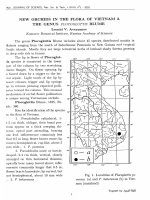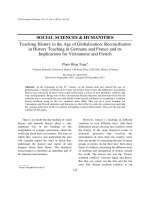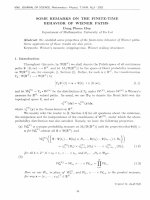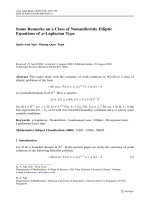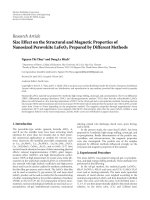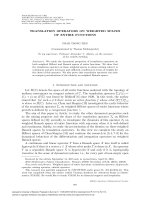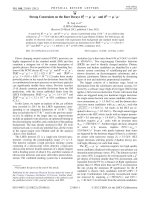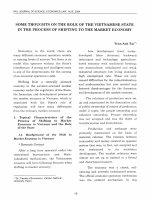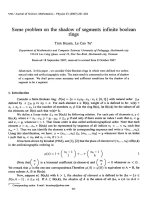DSpace at VNU: Experimental Study on the Motions of Prolate Spheroidal Particles under Electric Field
Bạn đang xem bản rút gọn của tài liệu. Xem và tải ngay bản đầy đủ của tài liệu tại đây (908.03 KB, 7 trang )
2626
T. Sangsri et al.: Experimental Study on the Motions of Prolate Spheroidal Particles under Electric Field
Experimental Study on the Motions of Prolate Spheroidal
Particles under Electric Field
Tatchawin Sangsri, Boonchai Techaumnat
Chulalongkorn University
Department of Electrical Engineering, Faculty of Engineering
Bangkok 10330, Thailand
Viet Quoc Huynh
Ho Chi Minh City University of Technology
Department of Electrical Engineering, Faculty of Electrical and Electronic Engineering
Ho Chi Minh City, District 10, Vietnam
and Kunihiko Hidaka
The University of Tokyo
Department of Electrical Engineering and Information Systems
Tokyo, Japan
ABSTRACT
This paper presents a study on the electromechanics of prolate spheroidal conducting
particles on a conducting plane. The objective of the study is to clarify the fundamental
role of the non-spherical shape of particles on their behavior under electric field. We
used two sizes of particles having the same major axial length but different diameter
(minor axes) for the experiments. The electric field EM initiating particle motion was
measured, and we found that EM was slightly higher than the theoretical field strength
of the particle for rotation. The lift-off behavior of the particles at EM was different
from the theoretical prediction as the particles departed from the conducting plane at
significantly larger angles than the theoretical prediction. The discrepancy of the
departing angle was possibly due to the predominant rotating motion of particles. With
higher electric field than EM, the experimental results showed that the linear vertical
motion of particles became dominant, resulting in virtually parallel lift-off of the
particles. However, re-contact might occur after lift-off between the particles and the
lower electrode, and increase the particle charge as a result. Charge estimation based
on the lying cylindrical model is found appropriate only when a particle has a small
aspect (length-to-diameter) ratio or when the field is much higher than the critical field
for particle rotation.
Index Terms - Electromechanical effects, electrostatic force, electric fields, prolate
spheroid, Insulation.
1 INTRODUCTION
A variety of high-voltage insulation systems utilize a gaseous
dielectric or a mixture of gaseous dielectrics as the main
insulating medium. Their advantage over systems with
atmospheric air insulation is that size reduction can be realized as
the dielectric strength of the gas insulated systems increases with
gas pressure. In addition, due to the nature of closed systems, the
influences from surroundings (pollution, etc.) are significantly
reduced; thus, gas insulated systems do not require frequent
maintenance.
Manuscript received on 3 September 2015, in final form 5 June 2016,
accepted 24 June 2016.
With the miniaturization of insulation systems, the electric
field becomes stronger inside. Small particles may exist in gas
insulated systems due to the manufacturing or assembling
processes. Particles may also result from mechanical operations
of moving parts. The existence of conducting particles in gas
insulated systems intensifies electric field near the particles [1].
The intensified electric field may lead to the occurrence of partial
discharge at the high-field region. Space charges accompanying
with the discharge process reduce the insulating capability of
gaseous dielectrics such as SF6. In addition to the field
intensification, free particles can move from one surface to
another by the electrical force. A conducting particle on an
electrode under electric field acquires charge from the contact,
DOI: 10.1109/TDEI.2016.005628
IEEE Transactions on Dielectrics and Electrical Insulation
Vol. 23, No. 5; October 2016
and the electrostatic force acts to lift or repulse the particle from
the electrode. The movement of particle complicates the electric
field and discharge behaviors, and promotes the discharge
inception in insulation systems [2]. In fact, it has been reported
that foreign conducting particles are a major cause of failures in
gas insulated systems [3].
Up to now, there have been a number of analytical and
experimental studies on particle behavior under electric field.
Most of the works deal with spherical particles. The induced
charge and electrostatic force on a conducting sphere were
analyzed [4-6]. The measured lift-off electric field of spherical
particles usually agreed well with the theoretical values [7-9].
The motion of uncharged spherical particle and the deactivation
was also demonstrated in [10]. However, particles in practical
insulation systems have a variety of shapes, not limited to
spherical one. Experiments on wire or elongated particles
showed complicated particle behavior under electric field such as
firefly, spinning, and rotation on an electrode [11-13].
The complex behavior of nonspherical particles are mainly
due to two factors: the particle profile and the corona discharge,
which changes the charge amount on the particles. This paper
presents an experimental study on the electromechanics of
conducting prolate spheroidal particles under electric field in
air. Owing to the curved surface of the spheroidal particles, it
is possible to suppress the corona discharge at the particle tip.
Thus, we can focus on the effects of particle shape on the
motion exclusively. The use of prolate spheroidal particle also
allows us to obtain the accurate solutions of electric field and
force by using an analytical method [14, 15]. The main
objective of this work is to compare the experimental results
with the analytical prediction and to clarify the fundamental
effect of particle profile on the movement of non-spherical
particle under electric field.
2627
same for both particle sizes. The minor axis or diameter was 1
mm and 2 mm for the smaller and larger particles,
respectively. That is, the aspect (length-to-diameter) ratio was
equal to 4 or 2 for the particles. Three samples were used for
each particle size. Figures 3a and 3b show the images of the
smaller and the larger particles, respectively.
2.3 PROCEDURES
Before each experiment run, the particle and the electrodes
were cleaned with ethanol and leaved to be completely dry at
room temperature. We applied the voltage in two manners.
First, to measure the critical electric field EM that initiated
particle movement, the applied voltage was increased by a
step of 0.1 kV until the particle moved. Second, the effect of
applied field strength on the particle movement was
investigated by applying a fixed voltage to the upper
electrode, which produced electric field higher than EM. We
carried out at least 10 tests on every sample for an
experimental condition. The relative humidity was kept below
60% in all experiments for the consistency of experimental
results.
Figure 1. Schematic diagram of the experimental setup.
2 EXPERIMENTS
2.1 EXPERIMENTAL SETUP
The schematic diagram of the experimental setup is shown
in Figure 1. A spheroidal particle was placed on the lower
electrode of a parallel-plate system. Each electrode has a
diameter of 40 mm. The lower electrode was grounded and set
on an XYZ stage (XYZLNG60, Misumi) for adjusting the
alignment to the upper electrode. Figure 2 shows the parallel
electrode. The gap between electrodes was set to 8 mm in the
experiments. The electrode system was connected to a highvoltage dc supply through a 1 Mprotective resistor. A highvoltage amplifier (610E, Trek) and a signal generator
(AFG3021B, Tektronix) were used as the supply. The voltage
was ramped from zero to the peak value in 30 ms and held for
270 ms at the peak (i.e., 300 ms duration in total). Movement
of particles in the electrode system was observed by using a
camera (EX-ZR200, Casio). Recorded images (up to 1,000
fps) were subsequently transferred to a computer for analysis.
2.2 SAMPLES
The conducting prolate spheroidal particles were made
from aluminum. Two particle sizes were used in the
experiments. The major axis or the axial length was 4 mm, the
Figure 2. Parallel plate electrodes.
(a)
(b)
Figure 3. 4-mm long prolate spheroidal particles used in the experiments: (a)
smaller particle having 1-mm diameter (minor axis) and (b) larger particle
having 2-mm diameter.
3 RESULTS AND DISCUSSION
3.1 CRITICAL FIELD EM FOR MOTION ONSET
From the experiments, we obtained the critical electric field
EM that initiated the particle motion. Figure 4 presents the
average, minimum and maximum of EM for each particle size
and applied voltage polarity. The field will be referred
2628
T. Sangsri et al.: Experimental Study on the Motions of Prolate Spheroidal Particles under Electric Field
hereafter as “the motion onset voltage” of particle. The figure
shows that EM is lower for the smaller particle. The average
value of EM hardly depends on the polarity of the applied
voltage although the deviation of the measurement results
seems to be larger for positive voltage application (negatively
charged particles).
Figure 4. Critical electric field EM for particle motion.
(a)
(b)
Figure 5. Analytical characteristics of electric field ER for particle rotation and
EL for lift-off: (a) smaller particle and (b) larger particle.
The behavior of spheroidal particles on a conducting plane
under an external electric field has been analyzed based on the
characteristic of two critical fields: ER for rotation about the
contact point between the particle and plane and EL for
vertical lift-off from the plane [15]. For the spheroidal
particles used in the experiments, we calculate ER and EL as a
function of the tilt angle between the major axis of the
particle and the lower electrode. The method of multipole
images, which is an analytical method, is used for calculating
the critical fields [15]. In the calculation, monopole and
multipole images are repetitively applied to the spheroid and
the grounded plane until the boundary conditions are fulfilled.
Multipoles up to the 20th order are used to realize high
accuracy. The calculated ER and EL curves are shown in
Figure 5. With increasing electric field, the figure implies that
a particle resting on the conducting plane ( = 0°) starts its
movement by rotating about the contact point when the field is
higher than ER(0°), which is about 0.72 and 0.89 kV/mm for
the smaller and larger particle, respectively. According to the
rotation, the tilt angle increases, thus reducing the field
strength EL needed for particle lift-off. For both particle sizes,
the field ER(0º) is higher than the minimal EL at 90º.
Therefore, the lift-off condition is satisfied by ER(0º) when
increases to an angle between 0º and 90º. When subjected to
the critical field magnitude ER(0º), the smaller and larger
particles are estimated to depart from the conducting plane at
angle d = 15° and 36°, respectively, as shown by the dotted
lines in Figure 5.
When we increased the applied voltage gradually, the
experimental results showed that the particles almost always
rotated before lifting from the conducting plane. This motion
behavior conformed to the prediction from the ER and EL
curves. Figure 6 shows an example of the particle motion in a
temporal sequence. The electrostatic force acting on a particle
at lying position ( = 0°) or at standing position ( = 90°) is
often used to estimate the motion onset voltage [11, 16].
However, the analytical and experimental results here indicate
clearly that the critical field ER for rotation should be the
appropriate criteria for the motion onset. For comparison, ER
values for the spheroidal particles are shown as the dashed
lines in Figure 4. The average values of the measured EM are
6.9% and 7.9% higher than the analytical ER for the smaller
and larger particles, respectively. Note that the voltage drop
caused by the series resistor in the test circuit can be neglected
before the particle motion take place, as our preliminary
experiments confirm that the voltage drop is much smaller
than the total applied voltage. The difference between EM and
ER(0°) values may be caused by surface forces between the
particles and the lower electrode.
Figure 6. Temporal sequence of the smaller-particle motion (from left to
right) when the applied voltage was gradually increased until particle moved.
3.2 ANGLE OF DEPARTURE
The departing angle d has an important contribution to the
particle behavior after lift-off as it determines the charge
amount on the particle. Although the measured EM agrees
quite well the prediction, we have found that the departing
angle d of the particles significantly differs from the
estimation obtained from the ER and EL curves. Figure 7
shows the cumulative distribution of d when the applied field
was gradually increased to EM. It is clear from the figure that
IEEE Transactions on Dielectrics and Electrical Insulation
Vol. 23, No. 5; October 2016
particles of both sizes departed from the electrode at angles
that were considerably greater than the predicted values (15°
and 36°) from Figure 5. For example, the median value of d
for the smaller particle in Figure 7a was about 42° and no
particle lifted from the conducting plane at angle smaller than
37°. For the larger particle, only a small portion of particles
lifted at d ≤ 36°.
2629
(a)
(b)
(a)
(c)
Figure 8. Cumulative distribution of the departing angle d of the smaller
spheroid (left) and larger spheroid (right) for different applied field strengths:
(a) E/ER = 1.1, (b) E/ER = 1.2, and (c) E/ER = 1.3. The symbols □ and ■
represent the cases of negative and positive voltage application, respectively.
(b)
Figure 7. Cumulative distribution of the departing angle d of (a) smaller and
(b) larger particles under critical field EM.
We further investigated the lift-off behavior when the
particles were subjected to higher electric field. The applied
electric field was about 10, 20 and 30% higher than the critical
field ER for = 0º. Figure 8 shows the cumulative distribution
of the departing angle d of the smaller and larger particles
under different applied electric fields. It can be seen from the
figure that for E = 1.1ER the distribution was well similar to
those in Figures 7 and 8, as most particles still departed at
large tilt angles. With increasing electric field, the particles
exhibited a higher possibility to lift from the lower electrode
at small departing angles. The lift-off behavior at the
intermediate field (E = 1.2ER) of the smaller particles may be
classified into two groups. That is, the particles either lifted
parallel to the lower electrode (small d) or departed from the
electrode at large d after rotation. On the other hand, the
larger particles exhibited a transition to the parallel lift-off
when E = 1.2ER. When we further increased the electric field,
almost all particles of both sizes lifted parallel to the lower
electrode. Note that for all cases, we hardly observed
departing angle d close to the estimated values.
The characteristic of d can be explained by considering the
influences of electrostatic force and torque. Figure 5 implies
that at any tilt angle when the electric field is higher than
EL corresponding to , the rotating motion coexists with the
vertical linear motion. While the vertical motion separates the
particle from the lower electrode, the rotation keeps the
particle in contact with the electrode. At the critical field EM,
the rotation is predominant over the vertical movement in the
early state. Hence, the particle remains on the electrode even
when the condition of lift-off (EL) is satisfied. This results in a
considerably large angle of departure. On the other hand,
when the applied electric field is much higher than EL, the
vertical motion becomes predominant. As a result, the particle
exhibits parallel or nearly parallel lift-off behavior.
It is also worth noting that the spheroidal particles moved to
the upper electrode after lift-off. No particle exhibited firefly
motion or spinning on an electrode. In addition, the average
values of the motion onset electric field EM did not depend
significantly on the applied voltage polarity. Therefore, we
consider that the effect of corona discharge on the EM value
was negligible in our experiments.
3.3 PARTICLE CHARGE
As already mentioned, the electric field and electrostatic
force on a particle are closely related to the amount of charge
on the particle. For simplicity, the induced charge may be
estimated using the infinitely long cylindrical model for lying
position or using the hemi-spheroidal model for standing
position [17]. However, our experimental results showed that
2630
T. Sangsri et al.: Experimental Study on the Motions of Prolate Spheroidal Particles under Electric Field
the charge on non-spherical particles varied significantly from
particle to particle due to the variation of the angle d. In
addition, we also found that in the case of parallel lift-off, a
particle might re-contact with the lower electrode after it
departed from the electrode. Figure 9 illustrates the re-contact
behavior in a temporal sequence. The particle already lifted
from the lower electrode in the leftmost image, and twice
made the re-contact with the electrode as can be seen from the
second and forth images from the left.
nonuniform with increasing tilt angle. Note that the use of the
method of images enables us to deduce the particle charge Q
readily from the magnitude of the monopole image without a
need to evaluate surface integral.
Figure 11 presents the cumulative distribution of the
estimated particle charge Q. We normalize the charge by the
maximal charge Qmax, which is obtained by using = 90°.
Note that the abscissa of the graphs in Figure 11 ranges from
the minimal charge, corresponding to = 0°, to the maximal
charge. For E = 1.1ER, we can see from the figure that the
distribution of charge follows the tendency of d shown in
Figure 8 because re-contact did not take place when the
departing angle was large.
Figure 9. Re-contact of a smaller spheroidal particle after departing from the
lower electrode. Particle images are shown in a temporal sequence from left to
right.
From the recorded particle motion, we consider the recontact between the particle and the electrode, and estimate
the particle charge at the departing angle. Similarly to the
force calculation, we determined the particle charge from the
electric field analysis by the method of multipole images [15].
Figure 10 shows the charge distribution, which is nonuniform
on the particle. The surface charge density is normalized by
EE0 where E is the permittivity of the surrounding medium.
The normalized charge density is given along the contour l
on the particle surface starting from the lower pole of the
particle, as illustrated in the inset. The abscissa is normalized
by the cord length L between the lower and upper poles of the
particle. It is very clear that the surface charge is concentrated
on the upper surface, and the distribution becomes more
(b)
(a)
Figure 11. Cumulative distribution of the particle charge ratio Q/Qmax for the
smaller spheroid (left) and larger spheroid (right) under different applied field
strengths: (a) E/ER = 1.1, (b) E/ER = 1.2, and (c) E/ER = 1.3. The symbols □
and ■ represent the cases of negative and positive voltage application,
respectively.
(a)
(c)
(b)
Figure 10. Distribution of charge on the surface of (a) smaller and (b) larger
spheroidal particles.
With higher electric field, we can see the role of the recontact on the smaller particles. For E = 1.2ER, most of the
smaller particles that departed at a small tilt angle d acquired
additional charge by the re-contact. Thus, the possibility of
minimal charging was still very low. Even with E = 1.3ER, a
large portion of particles still made the re-contact and the
particle charge was greater than Qmin by 40% or more.
On the other hand, the re-contact was less frequent for the
larger particles. With E = 1.2ER More than 60% of the larger
particles took the minimal charge (at = 0°). Increasing E to
1.3ER resulted in the minimal charge on almost all particles.
Note that difference between the distributions of particle
charge under positive and negative applied voltages is
IEEE Transactions on Dielectrics and Electrical Insulation
Vol. 23, No. 5; October 2016
noticeable in Figure 11 for the smaller particle. A possible
cause may be the influence of partial discharge whose
behavior depends on the charge polarity. We have measured
the corona inception electric field Ei where the smaller
spheroidal particle is fixed to stand on the lower electrode (
= 90°). The measured Ei value was 0.71 kV/mm under a
positive voltage application. This implies that while the
corona discharge is negligible before the inception of particle
motion, it may have an effect after the particle rotates to large
angle and departs from the electrode. However, further
works are needed to make a conclusive explanation on the
effect of voltage polarity.
The model of an infinitely long cylindrical lying on a
conducting plane under an external electric field gives particle
charge close to that for a lying prolate spheroid having the same
axial length and radius [18]. Hence, our results demonstrate that
the cylindrical model is appropriate when a particle has a small
aspect (length-to-diameter) ratio or when the applied field is
much higher than the critical field ER. For slender particles,
having large aspect ratios, the particle charge takes intermediate
values between the minimum and the maximum, and can be
significantly larger than the minimal charge.
4 CONCLUSIONS
In this work, we have carried out the experiments on
conducting prolate spheroidal particles and compared the
experimental results with the analytical prediction. The results
showed that the motion onset field EM of the particles agreed
well with the analytical field ER for particle rotation. The
particles rotated on the lower electrode before lift-off as
predicted from the analysis. However, we have found that the
concurrent rotation with the vertical movement results in a
departing angle considerably larger than the angle where the
applied field theoretically satisfied the lift-off condition. The
charge amount on the particles was investigated based on the
lift-off behavior. Slender particles tended to make a re-contact
with the lower electrode after lifting from the electrode, and
acquired more charges from the re-contact. As a results,
charge estimation from the model of lying cylinder was
appropriate only when a particle has a small aspect ratio or
when the external electric field is much higher than the critical
field for particle rotation.
ACKNOWLEDGMENT
B. Techaumnat and T. Sangsri thanks the Thailand Research
Fund (TRF) for the financial support. This research is also
partially support by the AUN/SEED-Net program, JICA.
2631
[4] N.-J. Félici, "Forces et charges de petites objets en contact avec une
electrode affecte d’un champ electrique", Rev. Gén. Elec., Vol. 75, pp.
1145-1160, 1966.
[5] M. Hara and M. Akazaki, "Analysis of microdischarge threshold
conditions between a conducting sphere and plane", J. Electrostat., Vol.
13, pp. 105-118, 1982.
[6] B. Techaumnat and T. Takuma, "Analysis of the electric field and force in
an arrangement of a conducting sphere and a plane electrode with a
dielectric barrier", IEEE Trans. Dielectr. Electr. Insul., Vol. 13, pp. 336344, 2006.
[7] S. Birlasekaran, "The measurement of charge on single particles in
transformer oil", IEEE Trans. Electr. Insul., Vol. 26, pp. 1094-1103, 1991.
[8] A. Khayari and A. T. Perez, "Charge acquired by a spherical ball
bouncing on an electrode: comparison between theory and experiment",
IEEE Trans. Dielectr. Electr. Insul., Vol. 9, pp. 589-595, 2002.
[9] K. Sakai, S. Tsuru, D. L. Abella, and M. Hara, "Conducting particle
motion and particle-initiated breakdown in dc electric field between
diverging conducting plates in atmospheric air", IEEE Trans. Dielectr.
Electr. Insul., Vol. 6, pp. 122-130, 1999.
[10]N. Phansiri and B. Techaumnat, "Study on the Electromechanics of a
Conducting Particle under Nonuniform Electric Field", IEEE Trans.
Dielectr. Electr. Insul., Vol. 20, pp. 488-495, Apr 2013.
[11]K. I. Sakai, D. L. Abella, Y. Khan, J. Suehiro, and M. Hara,
"Experimental studies of free conducting wire particle behavior between
nonparallel plane electrodes with AC voltages in air", IEEE Trans.
Dielectr. Electr. Insulat., Vol. 10, pp. 418-424, 2003.
[12]K. Asano, K. Anno, and Y. Higashiyama, "The behavior of charged
conducting particles in electric fields", Industry Applications Society
Annual Meeting, Vol.2., pp. 1353-1359, 1994.
[13]K. Asano, R. Hishinuma, and K. Yatsuzuka, "Bipolar DC corona
discharge from a floating filamentary metal particle", IEEE Trans. Ind.
Appl., Vol. 38, pp. 57-63, 2002.
[14]H. Viet Quoc, B. Techaumnat, and K. Hidaka, "Analysis on electrostatic
behavior of a conducting prolate spheroid under an electric field", IEEE
Trans. Dielectr. Electr. Insul., Vol. 20, pp. 2230-2238, 2013.
[15]B. Techaumnat, H. Viet Quoc, and K. Hidaka, "Three-dimensional
electromechanical analysis of a conducting prolate spheroid on a
grounded plane", IEEE Trans. Dielectr. Electr. Insul., Vol. 21, pp. 80-87,
2014.
[16]Y. Khan, K. I. Sakai, E. K. Lee, J. Suehiro, and M. Hara, "Motion
behavior and deactivation method of free-conducting particle around
spacer between diverging conducting plates under DC voltage in
atmospheric air", IEEE Trans. Dielectr. Electr. Insul., Vol. 10, pp. 444457, 2003.
[17]S. Boggs, "On-axis field approximations for a (semi-)spheroid in a
uniform field", IEEE Trans. Dielectr. Electr. Insul., Vol. 10, pp. 305-306,
2003.
[18]H. Viet Quoc, Study on The Electromechanics of Non-Spherical Particles
Under Electric Field in Dielectric Systems, Doctoral thesis, Electr. Eng.
Dept., Chulalongkorn University, Bangkok, Thailand, 2013.
Tatchawin Sangsri was born in Nakhon Si Thammarat,
Thailand, in 1990. He received the B.Sc. degree in
physics from Chulalongkorn University, Thailand, in
2012. He is now studying in the M Eng. degree at the
Department of Electrical Engineering, Chulalongkorn
University. His research area is high-voltage engineering.
REFERENCES
[1] T. Takuma and B. Techaumnat, Electric Fields in Composite Dielectrics
and their Applications, Springer, Netherlands, 2010.
[2] M. Hara, T. Yamashita, and M. Akazaki, "Microdischarge characteristics
in air gap between spherical particle and plane", IEE Proc. A - Physical
Sci., Measurement and Instrumentation, Management and Education Reviews, Vol. 130, pp. 329-335, 1983.
[3] M. M. Morcos, S. Zhang, S. M. Gubanski, and K. D. Srivastava,
"Performance of particle contaminated GIS with dielectric coated
electrodes", Industry Applications Conf., Vol. 2, pp. 725-731, 2000.
Boonchai Techaumnat (M'02) was born in Bangkok,
Thailand in 1970. He received the B.Eng. in 1990,
M.Eng. degrees in 1995 from Chulalongkorn
University, Thailand, and the doctoral degree in
electrical engineering from Kyoto University in 2001.
He joined the Faculty of Engineering, Chulalongkorn
University as a lecturer in 1995. He is now a professor
at the faculty. Dr. Techaumnat received the medal
prize for new scholars from the Thailand Research
2632
T. Sangsri et al.: Experimental Study on the Motions of Prolate Spheroidal Particles under Electric Field
Fund in 2005, the Nanobiotechnology Premium from the Institution of
Engineering and Technology (IET) in 2009, and the book prize from the
Institute of Electrical Engineers Japan in 2011 for "Electric Fields in
Composite Dielectrics and their Applications”. His research interests include
numerical field analysis, electrical insulation, bioelectromagnetics, and
particle electrokinetics.
Viet Quoc Huynh was born in Ben Tre, Vietnam in
1985. He received the B.Sc. degree from Ho Chi Minh
city University of Technology, Vietnam in 2008, and the
M.Sc. degree from Chulalongkorn University, Thailand
in 2011. He received his doctoral degree in 2014 from
the Faculty of Engineering, Chulalongkorn University.
He is now a lecturer at the Faculty of Electrical and
Electronic Engineering, the Ho Chi Minh City University
of Technology. His research interest is the analysis of
electric field in high voltage engineering.
Kunihiko Hidaka (M'76-SM'04-F'12) received the
B.E., M.E., and D.Eng. degrees from the University of
Tokyo in 1976, 1978, and 1981 respectively. Since
1987 he has been with the Department of electrical
engineering of the University of Tokyo and is now a
professor of electrical engineering. He has been
engaged in the development of electric field sensors,
research on electrical breakdown phenomena
concerned with high voltage technology, and has
specialized in computer simulation of high-voltage
structures. His work has won premiums and awards from both the Japanese
and British IEE and the Institute of Electrostatics Japan. He is Fellow of IEE
of Japan (IEEJ) and the Japan Federation of Engineering Societies (JFES). He
was acting as tthe 100th President of IEEJ.
